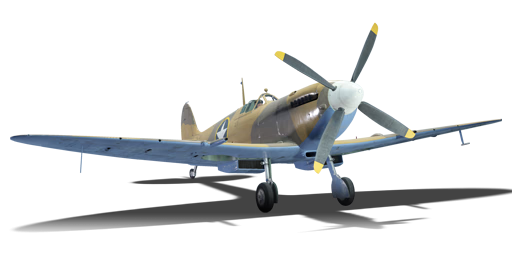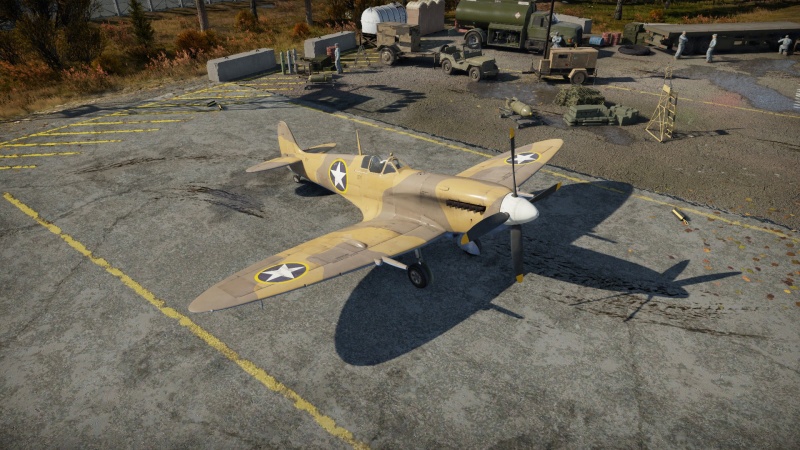Difference between revisions of "Spitfire LF Mk IXc (USA)"
Colok76286 (talk | contribs) |
m (→Pros and cons) (Tag: Visual edit) |
||
| Line 147: | Line 147: | ||
* Very low ammunition count, must be very conservative | * Very low ammunition count, must be very conservative | ||
* Poor engine performance at high altitudes | * Poor engine performance at high altitudes | ||
| − | |||
== History == | == History == | ||
Latest revision as of 19:33, 6 March 2024
| This page is about the American fighter Spitfire LF Mk IXc (USA). For other versions, see Spitfire (Family). |
Contents
Description
The ▃Spitfire LF Mk IXc is a premium rank IV American fighter with a battle rating of 5.3 (AB), 5.7 (RB), and 5.0 (SB). It has been in the game since the start of the Open Beta Test prior to Update 1.27.
General info
Flight performance
| Characteristics | Max Speed (km/h at 4,878 m) |
Max altitude (metres) |
Turn time (seconds) |
Rate of climb (metres/second) |
Take-off run (metres) | |||
|---|---|---|---|---|---|---|---|---|
| AB | RB | AB | RB | AB | RB | |||
| Stock | 632 | 611 | 11500 | 16.4 | 17.0 | 22.2 | 22.2 | 320 |
| Upgraded | 735 | 690 | 14.8 | 14.8 | 43.3 | 31.8 | ||
Details
| Features | ||||
|---|---|---|---|---|
| Combat flaps | Take-off flaps | Landing flaps | Air brakes | Arrestor gear |
| X | X | ✓ | X | X |
| Limits | ||||||
|---|---|---|---|---|---|---|
| Wings (km/h) | Gear (km/h) | Flaps (km/h) | Max Static G | |||
| Combat | Take-off | Landing | + | - | ||
| 774 | 270 | N/A | N/A | 230 | ~10 | ~4 |
| Optimal velocities (km/h) | |||
|---|---|---|---|
| Ailerons | Rudder | Elevators | Radiator |
| < 321 | < 400 | < 350 | > 470 |
Survivability and armour
- 38 mm Bulletproof glass in front of the pilot
- 3 mm Steel plate on top of fuel tanks
- 4 mm Steel plate on pilot's seat. Behind pilot is another 6-7 mm steel plate
- 3 mm Steel plates around ammunition
- Critical components located at the front of aircraft (fuel, pilot, engine, controls)
- Additional fuel tanks are located in the wings near the fuselage
Modifications and economy
Armaments
Offensive armament
The Spitfire LF Mk IXc (USA) is armed with:
- 2 x 20 mm Hispano Mk.II cannons, wing-mounted (120 rpg = 240 total)
- 4 x 7.7 mm Browning machine guns, wing-mounted (350 rpg = 1,400 total)
Suspended armament
The Spitfire LF Mk IXc (USA) can be outfitted with the following ordnance:
- Without load
- 1 x 250 lb AN-M57 bomb (250 lb total)
Usage in battles
All Spitfire versions served primarily as fighter aircraft. Due to its high manoeuvrability, the Spitfire LF Mk IXc excels in dogfighting, matched only by a few opponents (mainly Japanese). Due to its vulnerabilities, namely its low ammunition load and somewhat flimsy airframe, it is not recommended to attack bombers with heavy defensive armament. Its climb rate is one of the Spitfire's greatest advantages, being able to outclimb many rivals at its rank. Despite this, it is not recommended to try to catch up with zoom-climbing enemy fighters, because the Spitfire will most likely run out of speed before you manage to engage the opponent. Therefore, go into a shallow but high-speed climb to patiently gain the same altitude as the foe. Do not waste too much speed or altitude to the Boom & Zoom bounce from above, or else it will not work. In emergency situations, when an opponent is diving onto you, your speed is insufficient to face them and, when there are no clouds to hide in, you can descend to the tree-top level and use sharp turns and preferably uneven terrain to make dive attacks impossible for your opponent. He will most likely have to pull up before he can attack, due to his high speed. Exactly at that moment when he is pulling up, you can take initiative.
Manual Engine Control
| MEC elements | ||||||
|---|---|---|---|---|---|---|
| Mixer | Pitch | Radiator | Supercharger | Turbocharger | ||
| Oil | Water | Type | ||||
| Controllable | Controllable Auto control available |
Not controllable Not auto controlled |
Controllable Auto control available |
Combined | Controllable 2 gears |
Not controllable |
Pros and cons
Pros:
- Excellent rate of climb which will rival later Griffon Spitfires and most late war props
- Excellent acceleration from a standing start due to the boost configuration
- Good manoeuvrability, albeit lower than other Spitfires (I-V Marks)
- Extremely strong for its BR, similar or better flight performance to that of 6.7 super props
Cons:
- Features the British 7.7 mm 303 Browning machine guns
- Tendency to break its wings during high-speed manoeuvres
- Very low ammunition count, must be very conservative
- Poor engine performance at high altitudes
History
| Archive of the in-game description | |
|---|---|
|
Supermarine Spitfire Mk.IX (Type 361) single-engine interceptor fighter/front-line fighter A single-seat, single-engine, all-metal, low-wing cantilever monoplane fighter. Not only the British but also quite a few pilots from other countries fought on Supermarine Spitfire fighters. The Americans used Spitfires, as well.. The beginning of the Spitfire was marked by volunteers who had joined the ranks of the British RAF before the USA joined the war. In 1941, there were three full-fledged American fighter squadrons in Britain, named the Eagles. The Americans originally flew Hurricanes, but in August 1941 they started their retraining on Spitfires. Until the autumn of 1942, the Eagles were common British squadrons with the corresponding staff, uniforms, and markings. On September 29, 1942, thanks to an intergovernmental agreement, the Eagles were transferred to the command of the Eighth Air Force of the USAAF, located in Great Britain. Three squadrons were combined to form the 4th Fighter Wing, and the tricolour British cockades on the planes were replaced with American ones. Beginning in 1942, a number of the USAAF's fighter units which had arrived at the West European theatre of war without planes received British fighters as part of the so-called "Reverse Lend-Lease". These squadrons were originally based in Great Britain. Later, they were also based in North Africa. A total of about 1,000 Spitfires of various versions were handed over to the USAAF by the RAF. For example, the 52nd Fighter Wing was redeployed in July 1942 from the USA over the ocean to Northern Ireland. It was there that American fighter pilots had to master the Spitfire. The Americans flew Spitfires when they joined the North African Campaign in November 1942. American pilots fought in Spitfires in the North African theatre of war until the German troops were defeated in May 1943. The Americans used Spitfires (Mk.VIII and Mk.IX variants) in the skies over Italy as part of the Twelfth Air Force. By March 1944, the majority of the British planes had been replaced with Mustangs, but there were still some planes with those white stars on their fuselages all the way up until the Capitulation of Germany. | |
Media
- Skins
- Videos
See also
- Other late Merlin-engine LF variant Spitfires
External links
| Supermarine | |
|---|---|
| Spitfires | |
| Merlin engine | Spitfire Mk Ia · Spitfire Mk IIa · Spitfire Mk.IIa Venture I · Spitfire Mk IIb |
| Spitfire Mk Vb · Spitfire Mk Vb/trop · Spitfire Mk Vc · Spitfire Mk Vc/trop | |
| Spitfire F Mk IX · Spitfire F Mk IXc · Spitfire F Mk XVI | |
| Spitfire LF Mk IX · Plagis' Spitfire LF Mk IXc | |
| Griffon engine | Spitfire F Mk XIVc · Spitfire F Mk XIVe · Prendergast's Spitfire FR Mk XIVe · Spitfire F Mk XVIIIe · Spitfire F Mk 22 · Spitfire F Mk 24 |
| Export | ▄Spitfire Mk Vb/trop · ▃Spitfire LF Mk IXc · ▂Spitfire Mk IXc · Spitfire Mk IXc · Spitfire Mk.IX (CW) · Weizman's Spitfire LF Mk.IXe · ▄Spitfire FR Mk XIVe |
| Seafires | Seafire LF Mk.III · Seafire F Mk XVII · Seafire FR 47 |
| Export | ▄Seafire LF Mk.III |
| Jet fighters | Attacker FB 1 · Attacker FB.2 · Scimitar F Mk.1 · Swift F.1 · Swift F.7 |
| Hydroplanes | Walrus Mk.I |
| USA fighters | |
|---|---|
| P-26 Peashooter | P-26A-33 · P-26A-34 · P-26A-34 M2 · P-26B-35 |
| P-36 Hawk | P-36A · Rasmussen's P-36A · P-36C · ○P-36C · P-36G |
| P-39 Airacobra | P-400 · P-39N-0 · P-39Q-5 |
| P-40 | P-40C · P-40E-1 · P-40E-1 TD · P-40F-10 |
| P-43 Lancer | P-43A-1 |
| P-47 Thunderbolt | P-47D-22-RE · P-47D-25 · P-47D-28 · P-47M-1-RE · ⋠P-47M-1-RE · P-47N-15 |
| P-51 Mustang | P-51 · P-51A (Thunder League) · P-51C-10 · P-51D-5 · P-51D-10 · P-51D-20-NA · P-51D-30 · P-51H-5-NA |
| P-63 Kingcobra | P-63A-5 · P-63A-10 · P-63C-5 · ␠Kingcobra |
| Prototypes | XP-55 |
| F2A Buffalo | F2A-1 · Thach's F2A-1 · F2A-3 |
| BF2C | BF2C-1 |
| F3F | F3F-2 · Galer's F3F-2 |
| F4F Wildcat | F4F-3 · F4F-4 |
| F4U Corsair | F4U-1A · F4U-1A (USMC) · F4U-1D · F4U-1C · F4U-4 · F4U-4B · F4U-4B VMF-214 · F2G-1 |
| F6F Hellcat | F6F-5 · F6F-5N |
| F8F Bearcat | F8F-1 · F8F-1B |
| Other countries | ▃Ki-43-II · ▃Ki-61-Ib · ▃A6M2 · ▃Bf 109 F-4 · ▃Fw 190 A-8 · ▃Spitfire LF Mk IXc |
| USA premium aircraft | |
|---|---|
| Fighters | Thach's F2A-1 · Galer's F3F-2 · F2G-1 · F4U-4B VMF-214 · P-26A-34 · Rasmussen's P-36A · P-40C · P-43A-1 |
| P-47M-1-RE · ⋠P-47M-1-RE · P-51A · P-51D-10 · P-51D-20-NA · ␠Kingcobra · XP-55 | |
| ▃A6M2 · ▃Ki-43-II · ▃Ki-61-Ib · ▃Bf 109 F-4 · ▃Fw 190 A-8 · ▃Spitfire LF Mk IXc | |
| Twin-engine fighters | XP-38G · Bong's P-38J-15 · P-38K · YP-38 · P-61A-11 · XF5F · XP-50 · F7F-3 |
| Jet fighters | P-59A · F-86F-35 · F-89B · F-89D · F-4S Phantom II · F-5C · F-20A |
| Strike aircraft | A-1H · A2D-1 · AU-1 · XA-38 · AV-8A · AV-8B (NA) · A-6E TRAM · A-10A |
| Bombers | A-26C-45DT · B-10B · BTD-1 · PBM-3 "Mariner" · PBM-5A "Mariner" · PV-2D |





